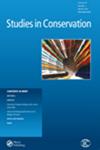14种天然染料在羊毛上的微褪色测试:5种媒染剂的比较
IF 0.8
4区 化学
0 ARCHAEOLOGY
引用次数: 0
摘要
摘要:采用微法测试(MFT)对用14种天然历史染料染色的标准羊毛样品进行了测试,每种染料都用5种不同的媒染剂制备,以确定这些染料的耐光性和色度特性是否随媒染剂的变化而变化。媒染剂的加入改变了染料的原始颜色以及对应于ΔL*、Δa*和Δb*的潜在图案,因此耐光性的变化范围为0.25–0.70单位的蓝毛当量(BWE)。不考虑媒染剂的影响,MFT表明所有染料的耐光性都相当于BW3,表明它们属于“高感光性”类别。所有染料的媒染剂组合的耐光性都各不相同,因此即使是最不耐光的染料,其媒染剂的组合也比最耐光的染色剂与使其不那么耐光的媒染液的组合更耐光。媒染剂的效果因染料而异:虽然一种染料的耐光性在最低耐光性和最高耐光性媒染剂组合之间可能相差0.56单位BWE,但另一种染料可能相差很小或没有差别(低至0.07单位BWE)。总的来说,明矾基媒染剂往往产生最不耐光的组合,其次是锡和铁,铜和铬产生最耐光的结合。本文表明,这14种天然染料与媒染剂的组合不存在简单的耐光性模式。识别染料和媒染剂有助于更好地评估染色纺织品的耐光性。本文章由计算机程序翻译,如有差异,请以英文原文为准。
Microfade Testing of Fourteen Natural Dyes on Wool: A Comparison of Five Mordants
ABSTRACT
Microfade testing (MFT) was used to examine standardized wool samples dyed with 14 natural historic dyes, each prepared with five different mordants, to determine whether the lightfastness and colourimetric properties of these dyes vary as a function of the mordant. The addition of mordants changed the original colour of the dyes as well as potential patterns corresponding to ΔL*, Δa*, and Δb* such that the variation of lightfastness ranges from 0.25–0.70 units of Blue Wool Equivalence (BWE). Disregarding the effect of mordants, MFT showed that all dyes have lightfastness equivalent to BW3, indicating that they belong in the category of ‘high sensitivity to light’. All dye-mordant combinations vary in lightfastness, such that even the least lightfast dye will have a mordant combination that is more lightfast than the most lightfast dye combined with a mordant that renders it less lightfast. The effect of mordants varies by dye: while one dye may demonstrate a difference in lightfastness of 0.56 units of BWE between the least and most lightfast mordant combination, another may show little or no difference (as low as 0.07 units of BWE). Overall, alum based mordants tend to produce the least lightfast combinations, followed by tin and iron, with copper and chromium producing the most lightfast combinations. This paper shows that there are no simplistic patterns of lightfastness between mordant-dye combinations with these 14 natural dyes. Identifying both dye and mordant is useful to better estimate the lightfastness of a dyed textile.
求助全文
通过发布文献求助,成功后即可免费获取论文全文。
去求助
来源期刊

Studies in Conservation
化学-分析化学
CiteScore
1.80
自引率
12.50%
发文量
73
审稿时长
>12 weeks
期刊介绍:
Studies in Conservation is the premier international peer-reviewed journal for the conservation of historic and artistic works. The intended readership includes the conservation professional in the broadest sense of the term: practising conservators of all types of object, conservation, heritage and museum scientists, collection or conservation managers, teachers and students of conservation, and academic researchers in the subject areas of arts, archaeology, the built heritage, materials history, art technological research and material culture.
Studies in Conservation publishes original work on a range of subjects including, but not limited to, examination methods for works of art, new research in the analysis of artistic materials, mechanisms of deterioration, advances in conservation practice, novel methods of treatment, conservation issues in display and storage, preventive conservation, issues of collection care, conservation history and ethics, and the history of materials and technological processes. Scientific content is not necessary, and the editors encourage the submission of practical articles, review papers, position papers on best practice and the philosophy and ethics of collecting and preservation, to help maintain the traditional balance of the journal. Whatever the subject matter, accounts of routine procedures are not accepted, except where these lead to results that are sufficiently novel and/or significant to be of general interest.
 求助内容:
求助内容: 应助结果提醒方式:
应助结果提醒方式:


